|
  |
|
Page 2 |
Newsletter 123, WInter 2018 © Hampshire Mills Group |
Eling - The Experience, and Tide Mill Maltings
Alison Stott,
Robin Appel
|
|
Eling - The Experience, by Alison Stott
Following our Annual General Meeting on 14 September
we had a talk by Ruth Kerr, one of the members of
the Eling Experience team. The Eling Experience
project encompasses the Tide Mill, the Heritage
Centre, and Bartley Water. Totton and Eling Council
run the site and the New Forest District Council own
the Tide Mill.
Ruth began by asking how many members had experience
of applying for a Heritage Lottery grant (hardly
any!). She explained that HLF have their own
objectives and if yours have nothing in common with
theirs then it will not work. Their main aims are
‘Heritage’, ‘People’, and ‘Communities’.
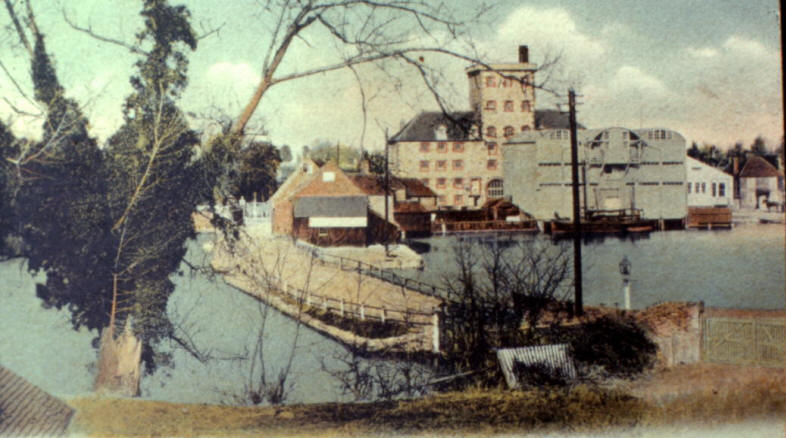
Copy of FGO Stewart postcard, about 1900, which
shows the tide mill and its causeway,
and the steam mill which burnt down in 1966 with its
grey silos on the waters edge.
|
|
Eling Experience has received a £1.7 million grant,
for capital works for the Tide Mill and the new
Heritage Centre and for ongoing work for the
community. It was particularly important to give a
good first impression upon entering the mill with
the new entrance. A large amount of work has been
undertaken to repair the machinery so that milling
can resume, and improved accessibility throughout
the mill enables all visitors to see everything
working.
The Heritage Centre has more information about the
mill with new displays in the Discovery Room, panels
with information, digital displays and some hands-on
activities. There is also a new café and extra
space for an activity room.
Outdoors the path to Goatee Beach has been widened
and levelled and a new footpath built right round
the millpond to create a circular walk accessible
for everyone including wheel-chair users. During
this time the team have worked with University
students, the New Forest Camera Club, local schools
and many other groups. They are making every effort
to involve local families.
|
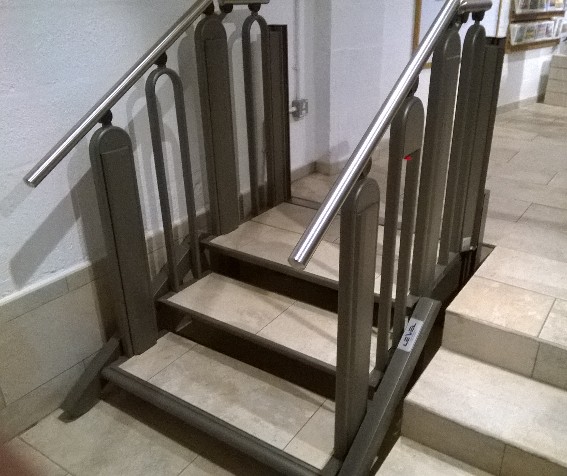
Keith Andrews
These steps at the entrance to the mill convert into
a flat-floored lift for disabled access, thereby
saving space over the more usual separate stairs and
lift arrangement. |
|
The
Eling Experience was formally opened in April and
they now hope to recruit more volunteers for tour
guides, to help in the café, and to go out and about
to events in the locality. There is a regular
programme of events with family activities, talks,
science, walks and so on.
Ruth was asked how they would maintain funding for
the future and she said they had a business plan,
including a farm shop as well as income from the
café and activities.
|

Ruth Andrews
Eling Experience (above) occupies the ground
floor
of the remains of the steam mill. |
0275.jpg)
Tony Yoward collection |
| |
|
|
Eling Tide Mill Maltings - Robin Appel
HMG’s recent visit to Eling Experience for the AGM
in September was my first visit to the tide mill.
Arriving early, and spotting our chairman on the
quayside, I sought his guidance on car parking, and
he directed me to the public car park. Walking back
across the causeway I was immediately struck by an
architectural feature on the so called ‘old grain
store’ which immediately told me I was probably
looking at a former maltings!
|
|
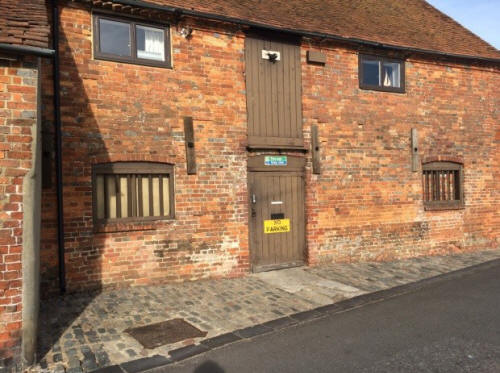
|
Two windows which face out over Bartley Water (left)
feature distinctive square shaped vertical wooden
bars, set at 45 degrees to the facia, all just 4
inches apart, identical to the windows that surround
my historic maltings in Warminster (below left,
enlargement of window on right). Back in the
18th/19th century these wooden bars were imposed on
the whole UK malting industry by the Commissioners
of Excise who were responsible for regulating and
collecting the Malt Tax.
|
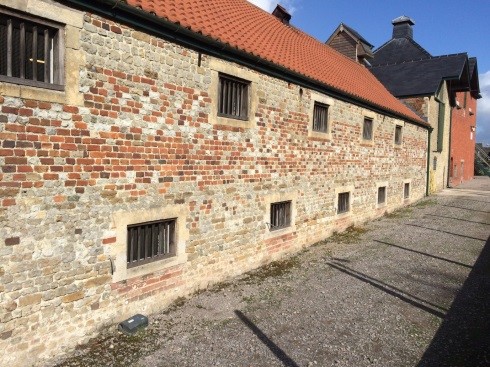 |
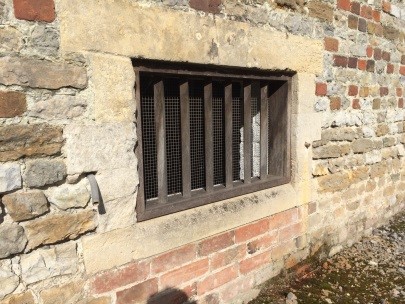 |
|
A duty on malt was first introduced in 1644 to meet
the growing costs of the Civil War, and over the
next 200 years the inelastic demand for beer made
the tax a soft target for government revenue in
times of need. In fact, right up to its repeal in
1880, it consistently generated in the order of 10%
of the total income from taxation. However, by the
end of the 18th century, the enormous dependence on
this one tax unleashed a complex web of legislation
to prevent fraud and evasion.
The tax was levied on volumes of malt produced, and
when the tax was hiked up in order to, for example,
build a new fleet of warships for the Napoleonic
Wars, maltsters struggled with the increase and
sought ways to avoid it.
No malt was allowed to be manufactured without
notifying the Excise Officers who had to measure the
volumes at 3 points in the production cycle: in the
steeping vessel, on the ‘couch’ ( the resting floor
for the ‘green malt’ between the steeping vessel and
the germination floors), and the germination floor
itself. The mean of the 3 volumes was that against
which the tax was levied.
|
|
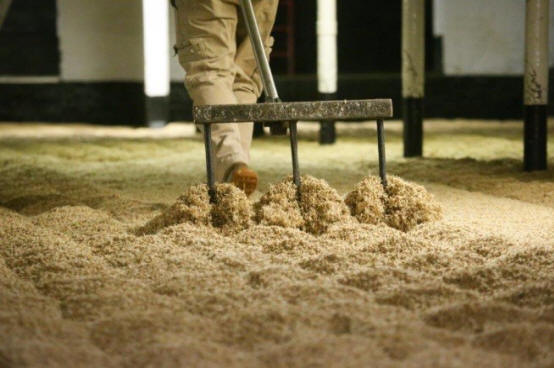 |
One trick employed by maltsters seeking to reduce
their tax bill was to temporarily remove green malt
from the germination floors ahead of the Excise
Officer’s visit. The ventilation windows along the
germination floors were the easy point of exit, and
when it was established that this was a widespread
practice, the window bars became part of the strict
regulations, subject to onerous fines if not
complied with. |
|
When I went on to read the guide book Eling Tide
Mill, the history of a working mill (2010 edition) a
whole lot more evidence of malting was revealed. On
page 8 it records that in 1581 there were “two water
wheels … each driving two pairs of stones. One pair
ground wheat, while the other (pair) crushed barley
for malt making”. No, that is not quite right, ‘the
other’ crushed malt for brewing – you do not crush
barley before you make malt, but you do have to
crush malt before you can brew beer!
It is also important to point out at this stage that
the millstones would not have been interchangeable;
crushing malt for brewing should deliver a very
coarse grist compared to the fine grist that is
flour. Each set of stones would have been dressed
accordingly.
Then on page 10 the guide records “There was also a
kiln for drying germinating barley for malt
brewers”. From the earliest photograph of the mill
displayed in the Eling Experience exhibition (a
photograph taken from the northern bank of
Southampton Water), the kiln is very evident, albeit
inconveniently situated on the eastern elevation of
the mill, furthest from the germination floors. The
kilning of the green malt is the final critical
stage of the conversion of barley into malt. This
photograph also clearly shows horizontal shuttered
windows on the first floor of the maltings, all
three of which are hinged half open for the
important ventilation of the germination floor when
malting was in process.
So all this suggests that half of Eling Tide Mill’s
original production was devoted to milling wheat for
flour for baking, and the other half was making
barley malt, and crushing the malt ready for
brewing. We still crush malt for small brewers at
Warminster Maltings today. Then, it was something a
lot of smaller maltsters had to do, because many of
their customers for malt would have been households
brewing at home, and milling the malt could have
been beyond their ability. My home in Droxford,
part of which is the former village malthouse
(1672), declared in 1771 that it had a ‘Malt Kiln
and Malt Mill …’ the latter probably a small pair of
stones, gravity fed, and turned by hand. By
comparison, Eling’s investment in a dedicated
Poncelet wheel driving a pair of stones, might have
been viewed at the time as positively industrial,
feeding a strong demand for milled malt.
Reading on, it is not surprising then, that also on
page 10 of the guide, it records “In 1885, there was
even trade in beer supplied by Ashby’s Brewery of
Totton”. No doubt this would be beer coming back on
the horse and cart which had just delivered malt to
the brewery.
Back to page 4 of the guide, and it records that
“The mill building today was probably built in 1785
by John Chandler”, a prosperous and enterprising
corn merchant, and “the adjoining brick building,
once the grain store … was added early in the 19th
century”. Instead of ‘grain store’ we need to
substitute the word ‘maltings’. This was the period
when the Malt Tax regulations, which included the
vertical wooden bars in the ventilation windows,
became overzealous, causing maltsters to complain to
the Commissioners of Excise that they were being
harassed “with a vigour beyond the law”, and accused
of “an apparent delinquency, where none by fair
procedure would be found to exist!”.
So it would appear Eling Tide Mill was making and
milling malt for brewing for nearly 250 years, a
significant part of its recent history. This has
not been fully understood, and does not come over in
the Eling Experience. This is something that should
be rectified, because, although a flour mill and a
maltings on the same site under a single proprietor
was not uncommon in the 19th century, for example at
Burnham Overy Mill in Norfolk, a tide mill based
maltings is extremely rare, perhaps even more rare
than a tide mill which once milled, or even still
mills flour, such as Eling.
In HMG Newsletter 122, I recorded that on this
year’s summer visit Richard Ellis told us that mills
always ‘shook themselves to bits’. From my own
knowledge and experience, maltings were always
catching fire: the juxta-position of coal fired
kilns and dried barley and malt grains. Here at
Eling, the tide mill has continuously been ravaged
by floods. So no wonder John Chandler found himself
rebuilding it all at the turn of the 18th and 19th
centuries. That the structures have withstood any
further serious damage beyond neglect is
particularly fortunate, as they represent a unique
piece of history which from now on HMG will probably
have to share with the Brewery History Society.
|
  |
|
|
